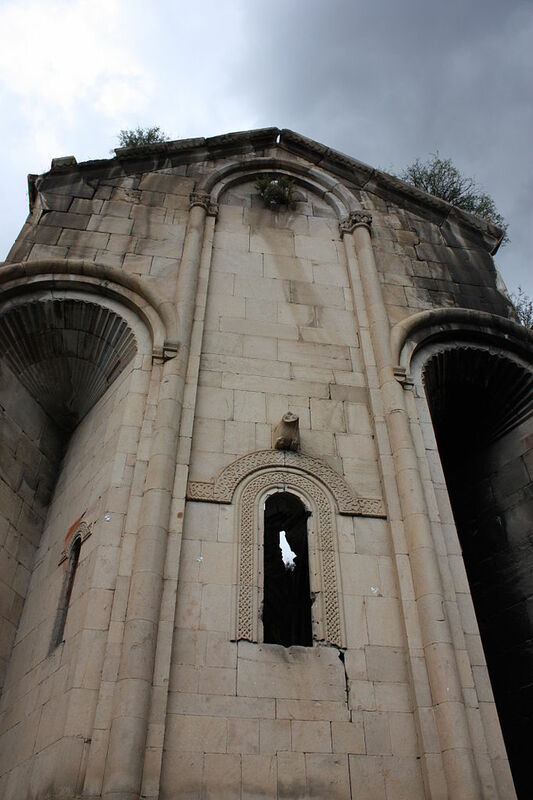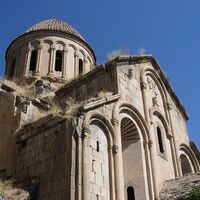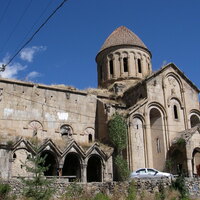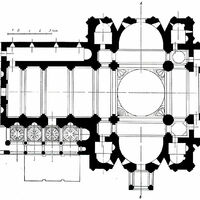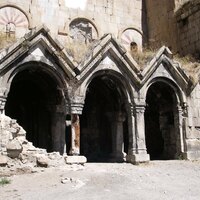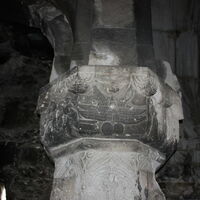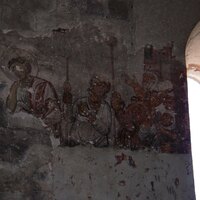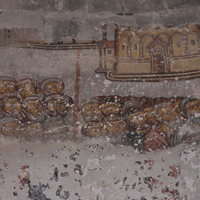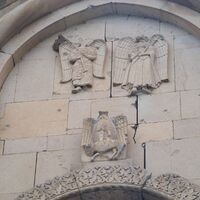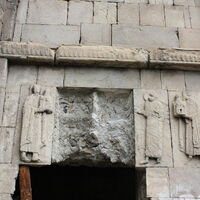Georgian monastery at Oshki
Type:
Churches,
Monasteries,
Sculptures,
Wall paintings
Date:
963–73,
1036
Location or Findspot (Modern-Day Country):
Turkey
Dimensions:
interior 40.6 × 27 m
Description:
Oshki was the site of a monastery dedicated to St. John the Baptist in what is now northeastern Turkey but in the tenth century was part of Georgia. The large monastery church built ca. 963–73 has a basilica plan with a triconch east end and a domed crossing tower (approx. 30 m tall and 9 m across). The nave had a ribbed barrel vault with a long, narrow chapel on its north side and a four-bay portico with four different kinds of vaults on the south side. This innovative vaulting is matched by the varied shapes and carvings on the vertical supports. After the Byzantines reconquered the region, they restored the roof in the 1020s.
An inscription dated 1036 in the apse credits Jojik Patrikios with the now fragmentary wall paintings. One in the south apse depicts a ceremonial procession before a nearby cathedral, probably commemorating the marriage in 1032 of the Georgian king Bagrat IV (r. 1027–72) to the niece of the Byzantine emperor.
The exterior at Oshki is articulated with numerous blind arches and figural reliefs. The founders are shown presenting miniature images of the church on the southeast corner (they flanked a Deesis scene, of which only John the Baptist is preserved).
Among numerous carved and painted inscriptions written in Old Georgian, one on the tympanum of the south cross-arm (above the main entrance) names two donors, the Bagratid king David kouropalates (r. 958–1001) and his brother Bagrat, "duke of dukes"), as well as the building supervisor, Grigol. It also itemizes the annual expenses of the monastery and the personnel and materials used to build the church, including different types of stone, iron, thirty oxen, and eighty men.
An inscription dated 1036 in the apse credits Jojik Patrikios with the now fragmentary wall paintings. One in the south apse depicts a ceremonial procession before a nearby cathedral, probably commemorating the marriage in 1032 of the Georgian king Bagrat IV (r. 1027–72) to the niece of the Byzantine emperor.
The exterior at Oshki is articulated with numerous blind arches and figural reliefs. The founders are shown presenting miniature images of the church on the southeast corner (they flanked a Deesis scene, of which only John the Baptist is preserved).
Among numerous carved and painted inscriptions written in Old Georgian, one on the tympanum of the south cross-arm (above the main entrance) names two donors, the Bagratid king David kouropalates (r. 958–1001) and his brother Bagrat, "duke of dukes"), as well as the building supervisor, Grigol. It also itemizes the annual expenses of the monastery and the personnel and materials used to build the church, including different types of stone, iron, thirty oxen, and eighty men.
Relevant Textbook Chapter(s):
6
Repository and Online Resources:
• Read more about Oshki on the Courtauld website "Crossing Frontiers."
• See a short video by the World Monuments Fund.
Image Credits:
Wikimedia Commons; Flickr
